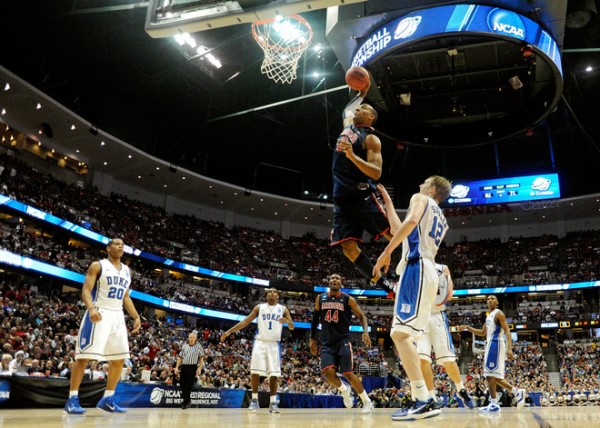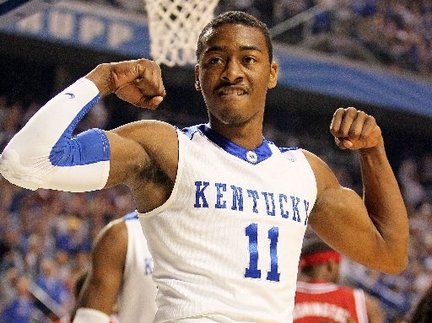One-and-Done Rule: Status Quo With Several (Not Good) Options…
Posted by rtmsf on December 1st, 2011An interesting thing happened last weekend. The NBA lockout came to a close and the single most impactful aspect of the labor negotiations on the sport of college basketball was left on (or under) the table without a decision yet made. It had been widely speculated for months, even years, that NBA ownership was heavily in favor of changing its draft eligibility rule from the current much-maligned one-and-done format — where players are eligible for the NBA Draft one year after their high school class graduates and when they turn 19 years old – to the more brand-friendly two-and-through/20 years old format. The general idea behind this proposal is to protect owners from themselves in drafting unproven prospects with the dreaded ‘upside’ moniker attached, as well as to allow players to develop from both a maturity and basketball standpoint. And don’t discount the ever-important marketing perspective — it’s far easier for a team to promote a Derrick Williams after he destroys Duke in the NCAA Tournament than a Monta Ellis who nobody has ever seen play before.
This issue, along with several other “B-list” considerations such as drug screening and D-League assignments, will have to be sorted out prior to finalization of the collective bargaining agreement between players and owners tentatively scheduled for next Friday, but perhaps the most intriguing development is that, according to this Yahoo! Sports report, the league may in fact simply come to terms with the players in formulating a committee to study the matter further. Say what?
The shelving of the age minimum debate buys the league more time to deal with the high-profile and impactful issue.
How much more time does the NBA need? Not only has one-and-done been in effect since the 2006 NBA Draft (over five years ago), but couldn’t someone have put a few hours toward researching this topic during the 149-day lockout period? The league and players know what the issues are here, and they’ve known for a considerable amount of time. Yet, what’s perhaps even more perplexing is that one of the apparent motivators for studying the options available is to look at the tried-and-true MLB model where players can enter the draft after high school, but if they choose to enter college, they must stay for two or three years.
Within the NBA, there’s a growing movement to create a rule similar to Major League Baseball, which requires college players to stay three years before becoming eligible for the draft. […] The proposed committee would look at a system that would permit high school players to declare for the draft, and if players aren’t selected, they can retain eligibility and still play college basketball.
Not only would this be a disastrous move for college basketball in terms of attracting top amateur talent, but it flies in the face of what we’ve heard from NBA people for years as the primary problem. Allowing the next Kevin Garnett, Lebron James and Tracy McGrady to declare for the draft out of high school has never been at issue; it’s allowing the next Jonathan Bender, Eddy Curry and Kwame Brown to do so. General Managers got themselves in trouble in trying to evaluate high school players without much else to go on other than a few AAU camps and individual workouts while prospects were shielded by agents. How does re-opening this option to high school players again help things?
And forget about evaluation – what about player marketability? Kyrie Irving from Duke or John Wall from Kentucky is a much easier sell to NBA fans than Shawn Livingston from Peoria HS or Martell Webster from Seattle Prep HS ever was. By the time Irving or Wall ended up posing for photos in their new professional uniforms, everyone had seen them play. Even if both Irving and Wall are busts, we’re wagering that they sold more jerseys combined in their first month of action than the other guys ever have.
Furthermore, there are sixty slots in each year’s NBA Draft. Keeping in mind that the top 50 seniors all think they’re going League, why wouldn’t every one of them simply declare for the draft, armed with the knowledge that they can go to the school of their choice anyway if they don’t like their selection? If we assume that the top ten or so players in any given high school class are likely to be selected somewhere in those two rounds, well, there goes at least five or more potential All-America caliber players over the next few seasons in college basketball. Instead of thriving with marketable stars for two-year windows, college basketball will again become relegated to the place where players end up if they’re not good enough for the NBA. We’ve all heard the jokes — if you’re a college basketball senior, you pretty much suck. You might not think this matters much, but to casual fans, it does.
To put it in contemporary terms, the fear is that without A-list collegiate stars like UNC’s Harrison Barnes, Ohio State’s Jared Sullinger, Kentucky’s Anthony Davis, Duke’s Austin Rivers, Connecticut’s Andre Drummond, and so on, that college basketball becomes more like the Patriot League than it should (no offense, PLers). All of us here will watch and cheer the players who end up on college teams one way or another, but Mr. Casual Sports Fan will become increasingly less interested in a sport that from a talent perspective is such a major step down so as to almost become an afterthought. Our game is too fantastic, especially in March, for it to become as irrelevant as college baseball, but an NBA draft eligibility model that encourages anyone who appears to be an eventual NBA prospect to throw his name into the draft after high school is one that will ultimately not end well for the sport.
Another option being bandied about this week is a rookie salary scale that would incentivize players to stay in school longer than they otherwise would be inclined. While certainly interesting, we can’t imagine that most high schoolers or even college freshmen would turn down $500,000 immediate dollars for the chance at $750,000 the next summer. If anything, there’s an element of fear that they could be exposed as overrated prospects (we’re looking at you, Abdul Gaddy, Josh Selby, etc.), which would likely incentivize the more marginal talents with the elusive ‘upside’ to take the money and run.
As for the immediate future, it appears that while the NBA studies this issue, the one-and-done rule will remain in effect for the 2012 NBA Draft. One of the reasons given is that NBA execs believe that an infusion of talent in next year’s draft (Drummond, Davis, Rivers, and so on) might help win fans back who were disillusioned by the labor issues. Perhaps partially, but it might be a short-sighted play on the league’s part. If it ultimately leads to a situation where random mid-tier high school players are declaring for the draft and getting selected, we’re back to where we started in the late 1990s when GMs lost sight of what works best for their business models.
Nevertheless, if Kentucky fans in particular were hoping to see two seasons of their spectacular freshmen class together, they’d better hope that the Wildcats cut down the nets in New Orleans in April because they’re unlikely to get another go at it. If we’re reading the NBA labor tea leaves correctly, such a superbly talented team will be all-but-impossible in college basketball’s future, and that’s nothing short of disappointing.













































Nice summary of the one and done from both the college and pro perspective. But you kind of leave out the why college fans dislike the 1 and done. It brings in 8 month mercenaries who really don’t want to be there; it feels extremely phoney not to mention brings the baggage of their future payday.
Here is how I’d change it 2 years in college or 1 year in a pro league after HS. D-league counts as a pro league. This would pretty much lead most top talent into college.
Makes them choose between immediate fame and better coaching to sacrifice one year or being paid peanuts and bussed around to play in front of no one for a year. Or they could go overseas get paid more but that is a step up in competition from college ball not to mention the culture shock.